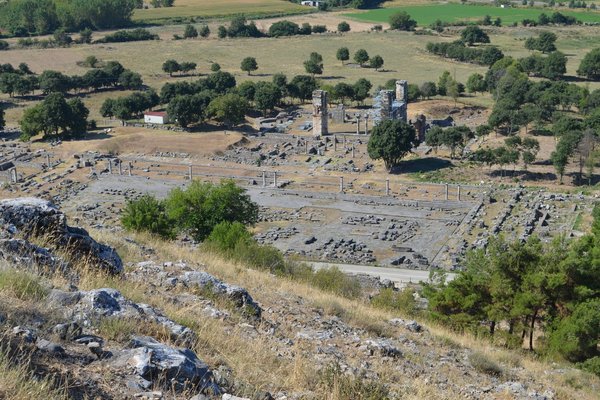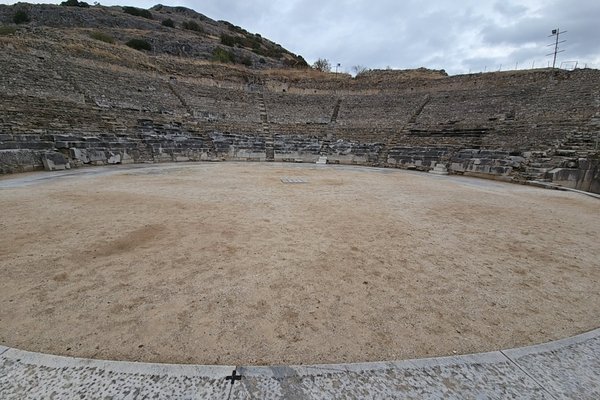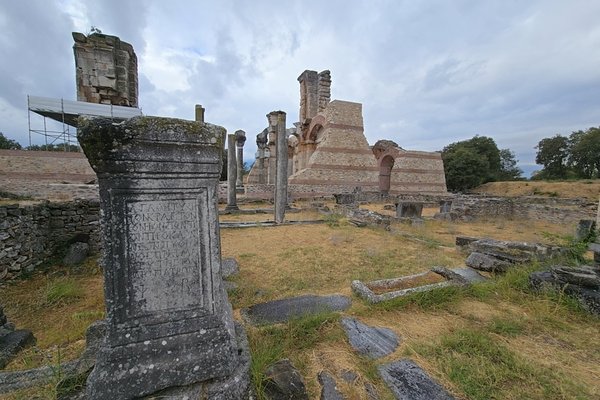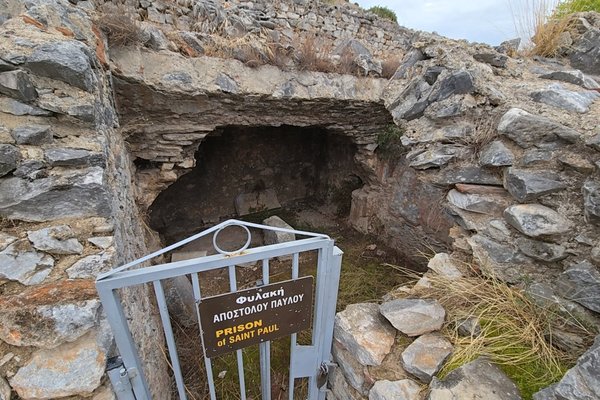Greece
Archaeological site of Philippi
The Archaeological Site of Philippi comprises the ruins of a city that saw its heyday in Roman and Early Christian times.
Philippi was founded in 356 BCE by the Macedon King Phillip II on a strategic location on the east-west route through his empire (later this became the Via Egnatia). When it became a Roman colony, the Hellenistic city was transformed by adding Roman public buildings. The city later became a Christian pilgrimage site, because it had been visited by the Apostle Paul around 49 or 50 CE, and was extended with Early Christian architecture such as the Basilica.
Community Perspective: With its Roman and Christian roots it differs greatly from other Greek WHS from Antiquity – although it needs “a lot of faith and/or imagination to breathe life into its dead stones”. The site can be visited as a day trip from Thessaloniki (take a bus to Krinides), and expect to spend around 2 hours at the site.
Site Info
Official Information
- Full Name
- Archaeological site of Philippi (ID: 1517)
- Country
- Greece
- Status
-
Inscribed 2016
Site history
History of Archaeological site of Philippi
- 2016: Revision
- 2 locations concerning the Battlefield of Philippi withdrawn on advice of ICOMOS (by letter of 27 February 2016)
- 2016: Inscribed
- Inscribed
- 2014: Revision
- Renomination under the same name at the new tentative list of Greece
- Type
- Cultural
- Criteria
- iii
- iv
Links
- UNESCO
- whc.unesco.org
- Official
-
- visitkavala.gr — Visit Kavala: Philippi
- Related
-
- dikili-tash.gr — Research at Philippi
All Links
UNESCO.org
- whc.unesco.org — whc.unesco.org/
Official Website
- visitkavala.gr — Visit Kavala: Philippi
Related Resources
- dikili-tash.gr — Research at Philippi
News Article
- April 4, 2024 smithsonianmag.com — Archaeologists Find Ancient Statue of Apollo at Philippi
- Sept. 30, 2022 greekreporter.com — Stunning Statue of Hercules Uncovered in Philippi
- May 25, 2018 news.gtp.gr — Greece’s Ancient Philippi Set for Restoration, Upgrade Works
Community Information
- Community Category
- Archaeological site: Ancient Rome
Travel Information
Recent Connections
-
Perfect Inscriptions
2016 -
Hellenistic Greece
The vibrant Hellenistic city of Philip … -
On Euro coins
Commemorative 2 euro coin Greece 2017
Connections of Archaeological site of Philippi
- Trivia
-
-
On Euro coins
Commemorative 2 euro coin Greece 2017
-
- History
-
-
Hellenistic Greece
The vibrant Hellenistic city of Philip II, of which the walls and their gates, the theatre and the funerary heroon (temple) are to be seen. (OUV)
-
- Architecture
-
-
Octagons
The Octagon Church -
Mosaic art
At the Octagon (floor mosaics)
-
- World Heritage Process
-
-
Part of Cultural nomination rejected
The 2014 T List entry for Philippi included the Battlefield and "The rock art in the Lekani foothills, approximately two kilometres east of the city of Krenides, depicting human and animal figures and the distinctive horseman.... The important mines in the area east of Philippi and northeast of the ancient port of Neapoli (modern-day Kavala), identified with those referred to by Herodotus and Thucydides as Skapte Hyle." The latter 2 elements didn't appear in the Nomination file but the Battlefield did as a "second component". ICOMOS didn't find "authenticity" and Greece removed it. -
Perfect Inscriptions
2016
-
- Religion and Belief
-
-
Christian Pilgrimage Sites
Centre of Christian pilgrimage deriving from the visit and mission of the Apostle Paul in 49/50 CE. (AB ev) -
Mentioned in the Bible
According to the New Testament, in AD 49 or 50, the city was visited by the apostle Paul (Acts 16:9-10). From the Acts of the Apostles (Acts 16:12) and the letter to the Philippians (Philippians 1:1), early Christians concluded that Paul had founded their community. Accompanied by Silas, Timothy and possibly Luke, the author of the Acts of the Apostles, Paul is believed to have preached for the first time on European soil in Philippi (Acts 16:12-40). According to the New Testament, Paul visited the city on two other occasions, in 56 and 57. (wiki) -
St Paul was here
St Paul was imprisioned at Philippi and one of the buildings is known as "St Paul's Prison" (The traditional location where he baptised Lydia of Thyratara who thereby became the first recorded Christian convert in Europe lies just outside the inscribed area)
-
- Human Activity
-
-
Via Egnatia
"The 535 mile long Roman highway Via Egnatia joining Dyrrachium with Byzantion crossed the city from the Krinides gate to the Neapolis and was the main east-west street (decumanus maximus) of the city. Sections of the paving remain today, with large rectangular slabs of marble showing traces of cart wheels" (AB eval)
-
- Constructions
-
-
Protective Shelters
The mosaics of the Octagon are covered by a large protective shelter -
Baths
Balneum, part of the Octagon complex -
Acropolis
"The walls of the acropolis and the city date to the 4th century BCE period of the Macedonian King Phillip II and were extensively repaired during the Byzantine period" (AB eval) -
Theatres and Opera Houses
Ancient Greek Theatre
-
- Timeline
-
-
Built in the 4th century BC
founded in 356 BCE
-
- WHS Hotspots
News
- smithsonianmag.com 04/04/2024
- Archaeologists Find Ancient Statue…
- greekreporter.com 09/30/2022
- Stunning Statue of Hercules Uncove…
- news.gtp.gr 05/25/2018
- Greece’s Ancient Philippi Set for …
Recent Visitors
Visitors of Archaeological site of Philippi
- Adrian Turtschi
- Alexander Barabanov
- Alexander Lehmann
- Alex Marcean
- ALS
- Argo
- Atila Ege
- bergecn
- brornt
- Can SARICA
- Chinmaya
- christof
- Christoph
- Christravelblog
- ClaraHH
- Csaba Nováczky
- Dan Pettigrew
- David Berlanda
- Dimitar Krastev
- Dimitrios Polychronopoulos
- Elaine McArdle
- Els Slots
- emvcaest
- Femke Roos
- Harry Mitsidis
- henrik_hannfors
- Hubert
- Iain Jackson
- Ivan Rucek
- Jarek Pokrzywnicki
- Jawnbeary
- Joel on the Road
- John Smaranda
- Jonas Kremer
- k2flake
- KarenBMoore
- Karito Vies
- Kbecq
- Kevin McFarland
- Knut
- LaVale
- Lisu Marian
- Loic Pedras
- Maciej Gil
- Martina Rúčková
- Matthewsharris
- MAURO PODDA PANI
- Mia esguerra
- Mikan22
- Mikko
- Milan Jirasek
- nan
- Nihal Ege
- Patrik
- Paul Schofield
- Philipp Peterer
- Pincze
- Potsdamer
- Rachel Perkins
- Rafał Kałczuga
- Randi Thomsen
- Rick Ohm
- Roger Ourset
- Roman Bruehwiler
- Sabrina Liebehentschel
- Sehnsuchtsbummler
- Sergio Arjona
- Shandos Cleaver
- Simonh
- Solivagant
- Stanislaw Warwas
- Sutul
- Svein Elias
- Szucs Tamas
- Tamara Ratz
- Taotao Chen
- Tarquinio_Superbo
- Tatiana Nikulnikova
- Thomas Buechler
- Thomas van der Walt
- Tim Allen
- tony0001
- triath
- Tsunami
- Twobaconsandaboston
- UncleSlavi
- Viaje al Patrimonio
- Westwards
- Wojciech Fedoruk
- Yevhen Ivanovych
- Zoë Sheng
Community Reviews
Show full reviewsTwobaconsandaboston
A great little site with a nice museum
Archaeological site of Philippi (Inscribed)
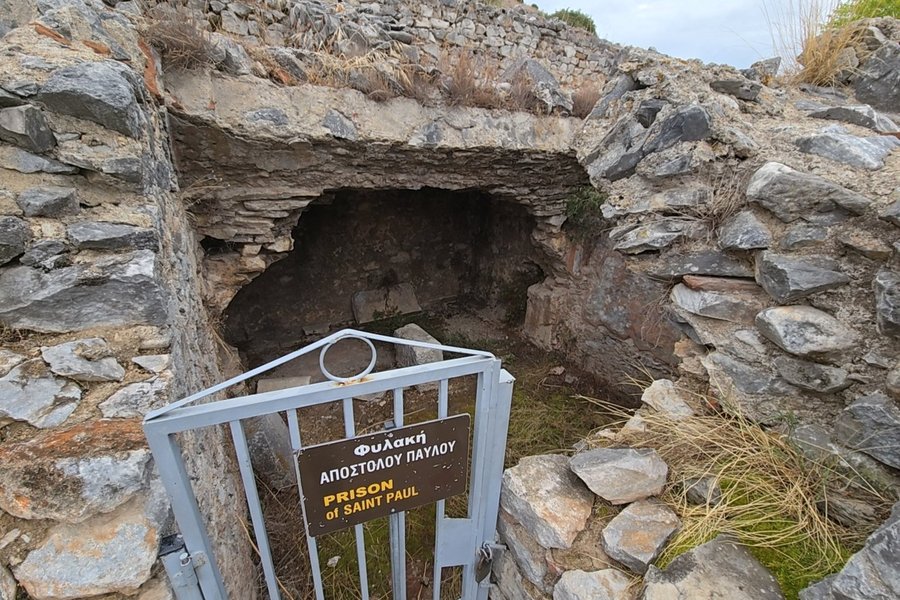
The last time this site was reviewed was over 6 years ago, so it needed a refresh. We visited this site in early October 2025. We had a hire car and drove to the town of Drama for the night and then visited this site first thing the next morning. The site opens at 8.00am and for reasons not known to me I put the Museum in the GPS to take me to the site and ended up exactly there which is the other end of the Archaeological site. No problems as you can enter here and buy tickets but there is very limited parking compared to the main entry gate. It ended up being the best option though, as we explored the site with very few other people before the crowds turned up and then visited the museum at the end, again in relative peace with no large crowds. It costs 6 Euro to visit the site and 10 Euro if you included the Museum, which I did.
The site has more structures than the previous archaeological site we visited in Aigai, however there is also some imagine still needed in exploring the site. Very good information boards though are provided to assist you in this. During our visit Basilica B area was unable to visited as they were undergoing restorative and stabilisation works in the area. You could still photograph the area from a reasonable distance but really could not examine the OUV details in this particular area. …
Keep reading 0 comments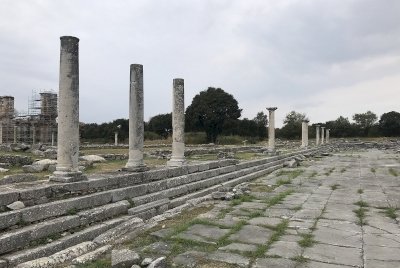
First things first: there is far less to see here than at most other ancient sites in Greece. The ruins are just that: ruins, and aside from the theatre, not particularly well-preserved. But it's the history here that really makes Philippi impressive. Given its name by King Phillip II of Macedon, father to Alexander the Great, it was also the site of a pivotal battle from Roman history. Just outside the city walls in 43 BC, an army lead by Julius Caesar's heirs Octavian and Mark Antony, faced off against an army lead by Caesar's assassins Cassius and Brutus. Caesar's heirs won the day, and the Roman Republic was no more. And of course, there's the connection with early Christian history as well - the Apostle Paul visited here and was thrown in jail for preaching in the Forum before making a miraculous escape. It's also reputedly the site of the first Christian church and first Christian baptism in Europe.
Honestly, a good knowledge of ancient history and some imagination are the best tools for fully enjoying this site. But despite the lack of ruins to see, it can still be quite an interesting and engaging 2-3 hour visit.
Logistics-wise, we drove to this site from our base in nearby Kavala. Aside from Athens, driving in Greece is actually quite OK as the roads are in fairly good condition. The site itself is quite a large area, and when we visited in September 2018 we had almost the …
Keep reading 0 comments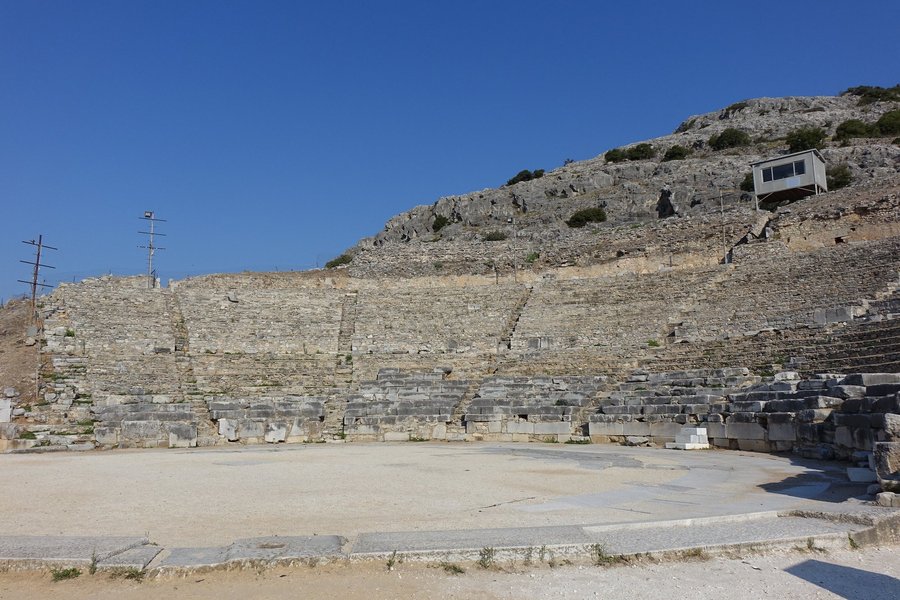
Philippi – now part of Eastern mainland Greece - developed into a strategic provincial town under Roman rule and became an early centre of Christianity. Although its remains are not up to par with the great Ancient Greek sites such as Olympia or Delphi, I found it interesting enough. With its Roman and Christian roots, it has a completely different background story than the other pure Greek WHS.
I walked around the archaeological site at ease for more than 2 hours. It is a large area that consists of different sectors. The path from the eastern entrance first passes the theatre. This originally Greek theatre was transformed by the Romans into an arena for animal fights. Their descendants, the early Christians, wanted to have nothing to do with that. They put it out of use and let it perish. Nowadays, it is again a recognizable theatre with rows of seats, where a theatre and music festival is held annually. Interesting reliefs and sculptures still adorn the outside of its walls.
Central to the site is an open square, the former Roman forum. Just like in the rest of Philippi, there is not much of it left: the city was destroyed by an earthquake in 619, but it looks like it happened last week. All stones that have fallen are still lying on the ground. Only the contours of structures, such as a row of shops, can still be seen.
At the edge of the archaeological site, there are two structures …
Keep reading 0 comments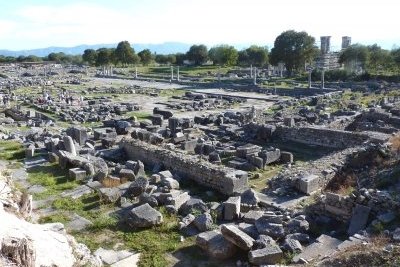
Oct 2017 - Another day in Greece….. another “Greek” ruin….! Well not really - ok Philippi is in Greece and was named by Philip II of Macedon in 356BC when he captured it for its nearby gold mines and strategic position, but this is no Delphi or Delos. There are some remains of “Greek” civilisation - but what you are going to see is primarily a late Roman colony planned as “Colonia Victrix Philippensium”. This occurred as “late” as 30BC following the Battle of Philippi 10 years earlier, and the city then developed into an early centre of Christianity - particularly from the 4th C, until it withered in the late 6th C.
Greece has only added 2 sites to its inscribed list in the 21st Century - Corfu in 2007 and Philippi in 2016. One can understand perhaps a certain reluctance to put forward yet more archaeological sites from classical “Greek” civilisation and the “Roman” and “early Christian” ruins of Philippi do “fill in” another period across the long “continuum” of Greek history. But I do wish they would get round to Knossos and Akrotiri!!
My main memory of Philippi is of a vast area of stone blocks hardly rising above ground level, which form the layout of the Roman City (Photo). Scattered around are a few taller pillars and walls, but the site lacks any really significant “sight” whether artistic or architectural. The, originally “Greek”, theatre is not particularly noteworthy among many such remaining …
Keep reading 0 comments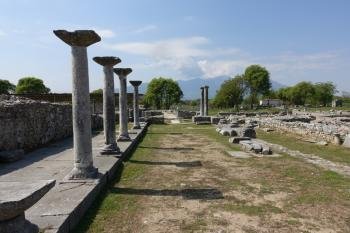
Philippi has a spot in the history books for two reasons. First, it was on the fields of Philippi that the Roman Republic ended when the final battle was lost to forces of Octavian and Markus Antonius. Then, it’s listed in the bible as the place Christianity came to Europe. Both events show in the ruins of Philippi. The city was remodelled by Octavian. And several early Christian churches were built here. Both have left there mark in the ruins you will get to see.
I spend roughly 1.5h on site which includes a nice museum. And while these ruins are great, Greece already has many sites listed from the period. I do wonder how many more Greek ruins should be inscribed?
Getting There
Coming in from Thessaloniki I followed Stanislaw’s description and it worked to a point. There are regular busses (normal, express) running more or less hourly from the main bus station in Thessaloniki to Kavala (2-2.5h). As far as I could tell the first bus runs at 8 a.m.
From Kavala jump on any bus to Drama and get off at Krinides. Important: There is also a town named Philippi, but the archeological site is in Krinides.
From Philippi you could connect eastwards towards Turkey. As much as I want to see the Hagia Sophia, given the current political situation I did not invest any time in researching this option.
Another interesting option is going North to Banska for Pirin …
Keep reading 0 comments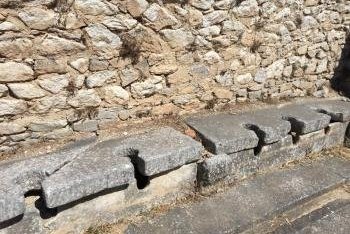
Visited August 2016.
It is possible to visit Philippi as a day trip from Thessaloniki, although you should start very early in the morning. Take the first bus to Kavala from KTEL Makedonia bus station at 6 am (around 2h20min) and change there for a local bus going towards Drama, get out in Philippi (20 min, lots of buses), very close to the entrance to the site.
The entry fee to the site and the museum is 6 €. You will get a leaflet with the plan of site and potential paths to follow. No guide or guide books in English available.
The site itself is not very enormous and comprises 3 parts. Acropolis situated above the archaeological remains contains mostly medieval walls and is not very spectacular, but the views from there are really nice: you get the panorama of the Roman and Christian sites and the battlefield from 42 BC. To get there involves a steep 30-minute hiking through the bushes – the path is not easy to find, it stars just behind the fence very close to the museum.
The other parts of the property are divided by a road that used to be part of Roman Via Egnatia. The upper part of the old walled city comprises Greek/Roman theatre, remains of some temple and footings of an old basilica, called Basilica A. Every year in August there is a Theatre Festival held at the site. Although the city was founded by Philip II of Macedonia, because …
Keep reading 0 comments
